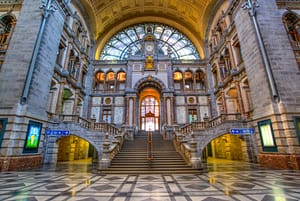MARKETS
Grand Place (Grote Markt)
Antwerp’s Grand Place (Grote Markt) with its town hall and numerous guild houses is the heart of the old town. In the middle stands the ornate Brabo Fountain erected in 1887 by Jef Lambeaux and depicting the Roman soldier Silvius Brabo tossing the severed hand of the giant Antigonus into the Scheldt. The Town Hall (or Stadhuis) dominates the plaza’s western side and was built by Cornelis Floris de Vriendt between 1561 and 1565. Inside, the rooms are hung with 19th-century paintings by H. Leys illustrating the history of Antwerp. Apart from the Stadhuis, most of the buildings bordering the Grote Markt are former guild houses (gildehuizen), which originally served as headquarters of the city’s 16th- and 17th-century guilds. Among the most interesting guild houses on the north side are the Gildehuis der Kuipers (Coopers’ House No. 5), the Huis van de Schutters (Archer’s House No. 7), and the Huis van de Kruideniers (Grocers’ House No. 11). Immediately behind the town hall, in the Gildekamersstraat, a former guild house has been turned into a Folk Museum devoted to the many traditional arts and crafts found in the Antwerp area, while nearby is the Ethnography Museum, which highlights non-European cultures.
MUSEUMS
Plantin-Moretus Museum
In 1576, Christophe Plantin the printer who hailed originally from France, moved into a house he christened “De gulden Passer” – the Golden Compasses – south of the Grote Markt. The house, lived in by Plantin and his Moretus family heirs is now a supreme example of Flemish Renaissance architecture. Today, the building is the Plantin-Moretus Museum incorporating the history of printing as well as showcasing the atmosphere of an Old Flemish patrician house. The original furnishings, wide-ranging exhibits, and above all, the still tangible atmosphere arising from the proximity of home and workplace make this museum one of Antwerp’s most fascinating tourist attractions. If you’re short on time, make a beeline for Room 7, devoted to the history of books and the processes involved in their production, from the earliest forms of writing and development of the alphabet – exhibits include important archaeological finds and manuscripts – to Johannes Gutenberg and the invention of letterpress printing using movable type. And afterwards, don’t miss Room 24, which is a celebration of the art of printing in Europe as a whole, the jewel in the crown being a 36-line Gutenberg Bible on display here.
Diamond Museum (Diamantmuseum)
The Diamantmuseum explores all the different aspects of the trade in diamonds, including sections on their extraction, processing, and industrial use. Diamond cutters can be seen at work. There is also a display of cut and uncut diamonds (genuine) together with copies of the more famous stones. Immediately south of the diamond museum lies the triangular Stadspark (City Park), on the site of one of Antwerp’s old defence works. Stocked with a fine range of plants, the park is attractively laid out with an ornamental lake, footpaths, and several monuments.
Museum Mayer van den Bergh
In the course of only a short period during the 1890s, a connoisseur of the fine arts, Fritz Mayer van den Bergh, assembled a remarkable collection of more than 3,000 items. These are now displayed on four floors of a Neo-Gothic house at Lange Gasthuisstraat 19 known as the Museum Mayer van den Bergh. The collection includes some superlative works of art, among them paintings by Pieter Bruegel the Elder, (Dulle Griet and the earliest of the artist’s signed works The Twelve Proverbs, both in Room 26), Rubens, Jordaens, Bouts, van der Weyden, van Ostade, Lucas Cranach, and Quentin Massys. Also of great interest are the Flemish and French religious statues, the outstanding collection of ivories, and a unique 16th-century Flemish breviary, and in Room 14, a polychrome group Christ with St. John (1300) by Henry of Constance and a Netherlands diptych (ca. 1400). The second floor features a collection of porcelain, while 17th-century furniture and paintings occupy the third.
Royal Museum of Fine Arts (Koninklijk Museum voor Schone Kunsten)
The nucleus of the collection inside the Royal Museum of Fine Art (Koninklijk Museum voor Schone Kunsten) belonged originally to the Lucas Guild of Painters and Sculptors, founded in 1442. Following the winding up of the guild in 1773, the works of art accumulated over the years passed into the possession of the Academy of Fine Arts. In the mid-19th century, however, the collection was swollen by a substantial number of new acquisitions, particularly gifts, mainly of 15th- and 16th-century paintings, from Florent van Ertborn, a former burgomaster of Antwerp. The academy found itself with insufficient space to accommodate the enlarged collection and the decision was taken to build a new museum. The collection is housed on two floors. The ground floor is largely devoted to 19th- and 20th-century paintings and sculpture, some 1,500 items in all, providing, among other things, an excellent overview of the development of the plastic arts in Belgium since 1830. The exhibition of Old Masters on the first floor comprises more than 1,000 works, mostly from the Flemish and Dutch schools. Note that the museum is undergoing renovation until 2018.

